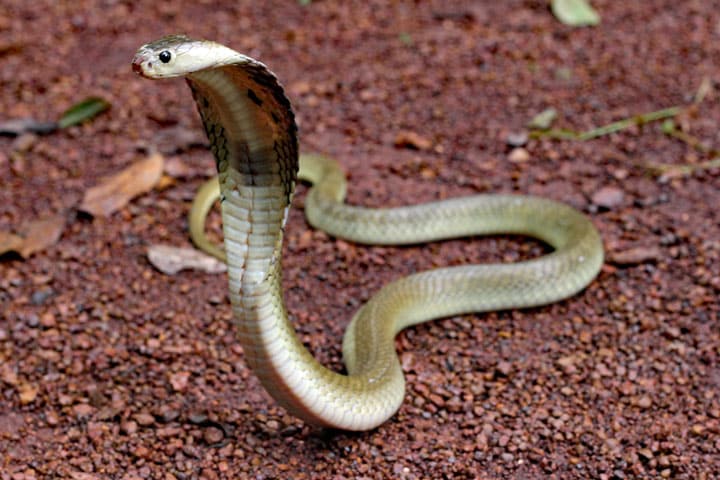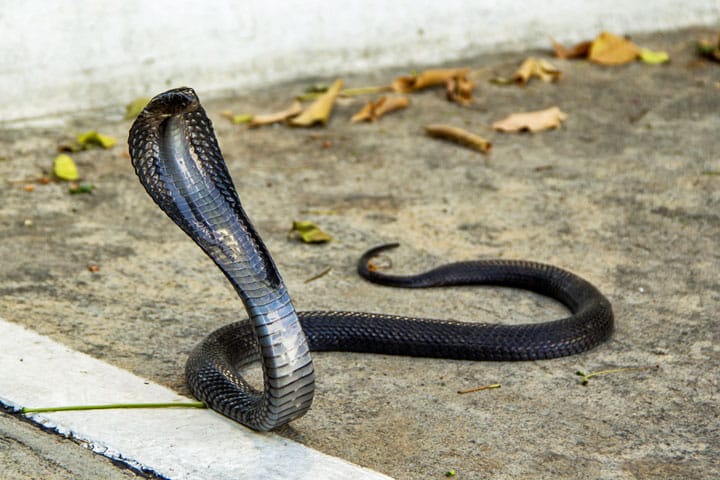
Also called the Thai spitting cobra, Siamese spitting cobra, or black and white spitting cobra, the Indochinese spitting cobra (Naja siamensis) is venomous to humans.
It is a medium sized snake and the species is thinner compared to other cobras. The color of the snake varies from gray to brown to black, with white spots or stripes. The very distinctive black and white colored snake is common in central Thailand, specimens from western Thailand are usually black, the color brown also occurs. Adult Siamese spitting cobras average 0,9 to 1,2 meters in length.
This cobra species is found in Southeast Asia, including Thailand, Cambodia, Vietnam and Laos. It is probably also found in eastern Myanmar. The snake lives in lowlands, hills, plains and forests. The reptile can also be found in the tropical jungle and is also seen near human settlements due to the abundant rodent populations in and around these areas. The Cobra usually feeds on rodents, toads and other snakes.
The snake is mainly active at night. Whether the snake is dangerous and aggressive depends on when the animal is encountered. When threatened during the day, the snake is generally timid and takes refuge in the nearest burrow. However, when threatened at night, the snake is more aggressive and may rear up and spit its venom. If the spit toxin doesn't work, the snake will attack and bite as a last resort. The Cobra will bite and not let go easily.

Like most other spitting cobras, the reptile's venom is dangerous to humans (postsynaptic neurotoxin and cytotoxin, necrotizing or tissue death). A bite causes a lot of pain, swelling and necrosis around the wound. The bite of this snake is potentially lethal to an adult human. Deaths have resulted from paralysis and consequent suffocation. This mainly occurs in rural areas where obtaining antivenom is difficult.
If you get the venom of the spitting snake in your eyes, you will immediately experience very severe pain, as well as temporary and sometimes even permanent blindness.
Special features and characteristics of the Siamese spitting cobra (Naja siamensis)
- Name in English: Indochinese spitting cobra or Thai spitting cobra, Siamese spitting cobra or black-and-white spitting cobra.
- Name in Thai:
- งูเห่าสยามพ่นพิษ, ngu haow Sayam ponn phit
- งูเห่าอิสานพ่นพิษ, ngu haow Isaan ponn phit
- งูเห่าด่างพ่นพิษ, ngu haow dang ponn phit
- งูเห่าพ่นพิษสีน้ำตาล, ngu haow ponn phit see namdtan
- งูเห่าดำพ่นพิษ, ngu haow damm ponn phit
- Scientific name: Naja siamensis, Josephus Nicolaus Laurenti, 1768
- Is found in: Southeast Asia, including Thailand, Cambodia, Vietnam, Laos and Myanmar
- Habitat: Lowlands, hills, plains and forests, but also in residential areas.
- Nutrition: Rodents, toads and other snakes
- Toxic to humans: Yes. The bite of this snake is potentially lethal to an adult human. Deaths have resulted from paralysis and consequent suffocation. This mainly occurs in rural areas where obtaining antivenom is difficult. If you get the venom of the spitting snake in your eyes, you will immediately experience very severe pain, as well as temporary and sometimes even permanent blindness.


This snakes section is very helpful. In fact, everyone should save a photo of all snakes so that you can get the right treatment in the hospital after a snake bite.
A relaxing walk in our garden in Thailand is not possible for the time being, this section scares the hell out of me. Thanks to the authors anyway!
There are about 200 snake species in Thailand, 60 of which are venomous and 20 deadly, storing all of them in your phone is not an option, take yourself or someone else a few pictures of the snake that bit you, so always take your smartphone with you
In the app store (mob tel) there are apps to determine the various species.
Over the years I have seen many snakes.
Even baby cobras attacking my lawnmower while mowing.
You don't see them in the grass, but they give you quite a scare.
Another question for the snake connoisseurs.
It is now very cold in Isaan and I regularly see snakes lying in the sun.
Mainly it's rat snakes and golden tree snakes that I've seen the last few weeks.
The more dangerous snakes don't warm up when it's cold?
Snakes are reptiles and cold-blooded. So they first have to warm up in the sun. If they are warm enough, they will hunt or hide from too much sun.
Also important to mention, if the poison gets into your eyes or on your skin, wash it out of your eyes and skin as quickly as possible.
Not washing your eyes out with water can also make you blind for life, not just temporarily.
When I was on holiday in Ceylon years ago, we also saw a spitting obra there. The guide then told us that if you get that poison in your eyes you should immediately rinse them out with milk.
Don't know if this is correct.
Because I have no experience whatsoever with spitting cobras, I checked the literature.
Rinsing with plenty of water is recommended. Preferably physiological salt, but that is usually not available. Rinse with liters of water, if necessary with ditch water if nothing else is available and go straight to the hospital. Lemonade if necessary.
Milk is also allowed and that probably works better.
If you don't have milk, there is often a nursing mother nearby. Milk is also excellent for pain relief.
Doing nothing usually leads to blindness.